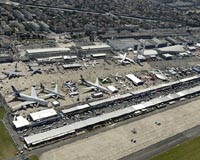 |
Paris (AFP) June 5, 2009 France sent a nuclear sub Friday to hunt the black boxes lost when an Air France jet carrying 228 people plunged into the Atlantic, as Airbus warned pilots about a possible cause of the tragedy. The notice, reminding air crews worldwide what to do when speed indicators give conflicting read-outs, was sent to pilots of all Airbus airliners and not just of the A330, the model that crashed Monday, a spokesman said. The alert came as French air safety investigators said automatic messages broadcast by the Rio to Paris flight just before it plunged into the Atlantic on Monday had shown the plane's systems were giving false readings. "Airbus overnight sent a reminder to all the companies using its planes on the procedures to follow in the case of inconsistency in speeds measured," a spokesman for the French-based manufacturer told AFP. With AF 477's black box flight recorders still missing, investigators are focusing on signals sent before the jet went down as it flew through a storm en route from Rio de Janeiro to Paris. The plane has several devices that measure speed but the data sent by them differed, said a spokeswoman from the Office of Inquiries and Analysis (BEA), France's air accident investigation authority. According to David Learmont, editor in chief of Flight International, the decision to issue the warning does not mean that investigators know what happened, but that they had seen similar situations in the past. "What Airbus is saying is, 'Whatever happened to these pilots, they didn't manage to handle it. We don't know everything that they faced but we know a little bit about the nature of the situation they faced'," he told AFP. "So all they've done is that they've gone back to the airlines and the pilots and said: have a quick look at this, because it might save your life." Airbus urged all the pilots to refer to a warning it already issued in July 2001 outlining what to do "In the event of erroneous airspeed in flight or at take off or if the airspeed indication is lost." Such a situation could be caused, the warning stated, if detection equipment known as "radomes" or "pitots" are damaged or obscured in flight. Pilots are told to turn off the autopilot, maintain flaps in position, check that speedbrakes and landing gear are retracted, apply thrust and adjust the pitch of the aircraft to maintain the right speed while avoiding a stall. "The aeroplane will reject the autopilot and you have to fly it manually and you have to make decisions about which information your systems are giving you is correct and which is not correct," Learmont said. French Defence Minister Herve Morin told reporters in Paris he had not ruled out an terrorist attack on the plane, although he had not heard of any threats or claims of responsibility being made. "I've never ruled out terrorism," he said. "There's no element or evidence trail that would allow us to corroborate that, but the inquiry that is under way has never ruled that out." Morin also said that a French navy nuclear-powered hunter-killer submarine had been sent to the area, where salvage crews are racing to find the wreckage and bodies of passengers in the Atlantic. "Time is against us," admitted French transport minister Dominique Bussereau. "We must do everything we can to find the flight recorders and certainly enlarge the search zone." Several Brazilian navy vessels and French and Brazilian planes, are scouring waters midway between Brazil and Africa for wreckage, including a seat and what appeared to be a big chunk fuselage, sighted by air force jets. Speculation over what caused the accident has ranged from terrorism, to turbulence, to pilot error or a combination of factors. No mayday call was received, just a series of automatic data transmissions signalling the plane's systems were shutting down one by one, after which it presumably broke up or went into a fatal dive. Brazil's air force has invited Brazilian relatives to its centre of operations in the northeastern city of Recife to observe developments. Some are to go to Fernando de Noronha, a Brazilian archipelago 400 kilometres into the Atlantic that serves as a base for the search and initial collection point for any debris or bodies that might be recovered. "We want to see how the search operations are going, how the searches are being carried out. It's important for us to see that," said one of them, Nelson Farias, whose son was on the flight. Recife, on the Brazilian mainland, has prepared a morgue and debris inspection area for anything found. burs-dc/ach Share This Article With Planet Earth
Related Links Aerospace News at SpaceMart.com
 Historic Paris Air Show planned
Historic Paris Air Show plannedParis (UPI) Jun 4, 2009 This month's 48th International Paris Air Show will celebrate its 100th anniversary -- the first Paris Air Show was held in 1909 at the city's Grand Palace. The 2009 event at Le Bourget Airport runs June 15-21, with more than 200 000 visitors expected to attend, the European Space Agency said. The ESA said it will participate with a 5,382-square-foot pavilion located between full ... read more |
|
| The content herein, unless otherwise known to be public domain, are Copyright 1995-2009 - SpaceDaily. AFP and UPI Wire Stories are copyright Agence France-Presse and United Press International. ESA Portal Reports are copyright European Space Agency. All NASA sourced material is public domain. Additional copyrights may apply in whole or part to other bona fide parties. Advertising does not imply endorsement,agreement or approval of any opinions, statements or information provided by SpaceDaily on any Web page published or hosted by SpaceDaily. Privacy Statement |